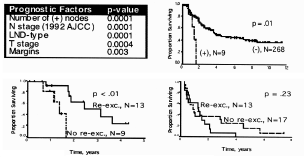Abstracts
1998 Digestive Disease Week
#3584
EFFECT OF MICROSCOPIC RESECTION LINE DISEASE ON GASTRIC CANCER SURVIVAL. S.H. Kim, M.S. Karpeh, D.S. Klimstra, D. Leung, and M.F. Brennan, Memorial Sloan-Kettering Cancer Center. New York, NY.
To study the effect of residual microscopic resection line disease in gastric cancer, we compared 47 patients with positive margins to 572 patients who underwent R0 resections using a multivariate analysis of factors effecting outcome. Although positive margins was a significant and independent predictor of outcome for the entire group (N=619, Table), this factor lost significance in patients who had undergone D2 or D3 lymph node dissections (N=466). However, subset analysis within the D2/D3 group determined that this finding was limited mainly to those patients with _ 6 positive nodes (N=189). In fact, the survival of patients who had < 6 positive nodes (N=277) was significantly worsened by a microscopically involved margin (Figure 1). Supporting this observation, intra-operative re-excision of microscopic disease based on frozen section resulted in a significant improvement in overall survival in patients with < 6 positive nodes (Figure 2) but not in those with _ 6 positive nodes (Figure 3).
|
|
TABLE. Multivariate analysis of entire population (N=619)
|
FIGURE 1. Effect of margins on survival if < 6 (+) nodes.
|
|

|
|
FIGURE 2. Effect of re-excision of pos. margins if < 6 (+) nodes.
|
FIGURE 3. Effect of re-excision of pos. margins if _ 6 (+) nodes.
|
|
We conclude that the significance of a positive microscopic margin in gastric cancer is dependent on the extent of disease. This factor is not predictive of outcome in patients who have undergone complete gross resection and pathologically proven advanced nodal disease. Thus, the goal in these cases should be an R0 resection when feasible but with the realization that the presence of N2 disease and not microscopic disease at the margin will mainly determine outcome.
Copyright 1996 - 1998, SSAT, Inc. Revised 29 June 1998.
|
 500 Cummings Center
500 Cummings Center +1 978-927-8330
+1 978-927-8330
 +1 978-524-0461
+1 978-524-0461